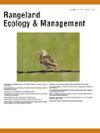Ranch-Level Economics of Lesser Prairie Chicken Conservation Practice Implementation
IF 2.4
3区 环境科学与生态学
Q2 ECOLOGY
引用次数: 0
Abstract
In 2022, the lesser prairie chicken's northern distinct population segment was listed as a threatened species under the Endangered Species Act and the southern distinct population segment was listed as an endangered species by the U.S. Fish and Wildlife Service. Approximately 95% of the land area of the species is in private land ownership. Conservation is thus focused on these lands with funding potentially supplied through Natural Resources Conservation Service (NRCS) conservation programs, most notably through the Environmental Quality Incentives Program (EQIP). Under EQIP, practice payments are made to landowners to implement planned conservation practices. Trees and uniform grazing are viewed as two of the main threats to the lesser prairie chicken over its range. We seek to estimate the economic impact of implementing lesser prairie chicken conservation practices on small and large representative ranches in 4 Major Land Resource Areas (MLRA). Models were developed in the General Algebraic Modeling System (GAMS) as recursive linear programs and run for 20 years using random cattle price sets and precipitation patterns for each MLRA. Baseline models were first developed to balance forage with the average herd size; conservation practice models that implemented practices on all or half the rangeland area, with the ranch paying 100, 25, or 0% of the conservation cost, were then compared to the baseline models. This modeling exercise shows that restoring lesser prairie chicken habitat on private ranches may or may not be profitable for the rancher or the ranch household. However, all of the scenarios show that with some level of financial assistance ranchers can implement LPC conservation practices without experiencing lasting negative impacts to their ranch or personal household incomes. The size of the ranch, how much area needs to be treated, the forage response to removing trees, cattle prices, and how much of the conservation practices need to be paid by the rancher all affect the profitability of restoration.
小草原鸡保护实践的牧场层面经济学实施
2022年,根据《濒危物种法》,小草原鸡的北部独特种群部分被列为受威胁物种,南部独特种群部分被美国鱼类和野生动物管理局列为濒危物种。该物种大约95%的土地面积属于私人所有。因此,自然资源保护局(NRCS)的保护计划,尤其是环境质量激励计划(EQIP),可能会为保护这些土地提供资金。在设备投资计划下,政府向土地所有者支付实施计划中的保护措施的费用。树木和统一的放牧被认为是对小山鸡活动范围的两个主要威胁。我们试图估计在4个主要土地资源区(MLRA)的小型和大型代表性牧场实施较少的山鸡保护措施的经济影响。在通用代数建模系统(GAMS)中开发模型作为递归线性程序,并使用随机牛价集和每个MLRA的降水模式运行20年。首先建立了基线模型来平衡饲料和平均畜群规模;然后将在全部或一半牧场面积上实施实践的保护实践模型,牧场支付保护成本的100%,25%或0%,与基线模型进行比较。这个模型表明,在私人牧场上恢复较小的山鸡栖息地可能对牧场主或牧场家庭有利,也可能不利。然而,所有的情景都表明,在一定程度的财政援助下,牧场主可以实施LPC保护措施,而不会对牧场或个人家庭收入产生持久的负面影响。牧场的规模、需要处理的面积、对砍伐树木的饲料反应、牛的价格以及牧场主需要支付多少保护措施的费用,这些因素都会影响恢复的盈利能力。
本文章由计算机程序翻译,如有差异,请以英文原文为准。
求助全文
约1分钟内获得全文
求助全文
来源期刊

Rangeland Ecology & Management
农林科学-环境科学
CiteScore
4.60
自引率
13.00%
发文量
87
审稿时长
12-24 weeks
期刊介绍:
Rangeland Ecology & Management publishes all topics-including ecology, management, socioeconomic and policy-pertaining to global rangelands. The journal''s mission is to inform academics, ecosystem managers and policy makers of science-based information to promote sound rangeland stewardship. Author submissions are published in five manuscript categories: original research papers, high-profile forum topics, concept syntheses, as well as research and technical notes.
Rangelands represent approximately 50% of the Earth''s land area and provision multiple ecosystem services for large human populations. This expansive and diverse land area functions as coupled human-ecological systems. Knowledge of both social and biophysical system components and their interactions represent the foundation for informed rangeland stewardship. Rangeland Ecology & Management uniquely integrates information from multiple system components to address current and pending challenges confronting global rangelands.
 求助内容:
求助内容: 应助结果提醒方式:
应助结果提醒方式:


